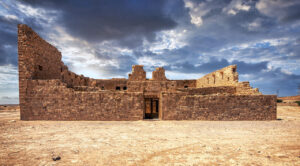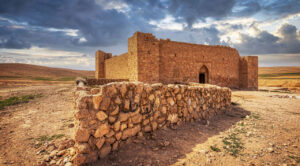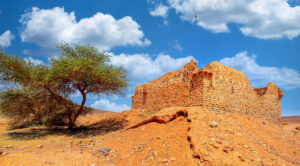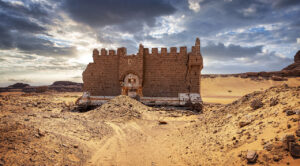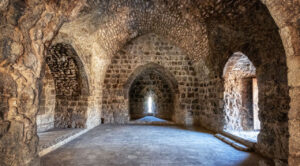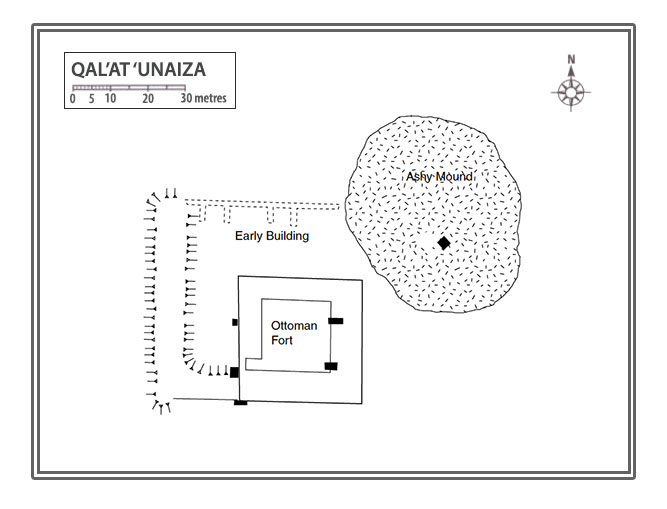Qal’at ‘Unaiza is an archaeological site nestled on the central Jordan plateau, just a stone’s throw from the Desert Highway. Approximately 400 metres to its east lies Mahattat ‘Unaiza, an old station from the historic Hijaz railway, while the village of Hashimiyya sits 3 kilometres to its north. Dominating the surrounding landscape is the striking Jabal ‘Unaiza, an extinct volcano situated 2 kilometres west of the fort. Its presence blankets the area in a delicate layer of basalt, providing a dramatic backdrop that complements the historic character of the site.
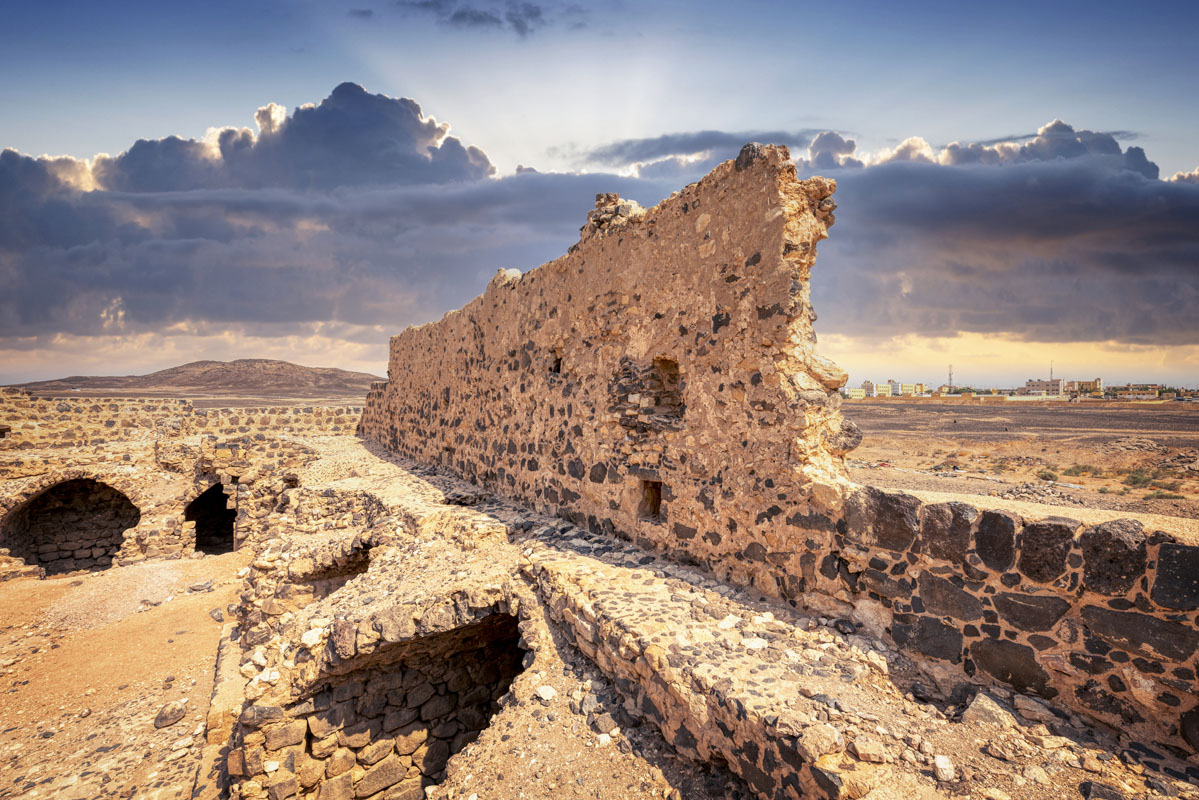
The centrepiece of the location is an imposing Ottoman-era fort, constructed with a perfect square footprint of 28 metres by 28 metres. Its robust black basalt walls are accented with creamy white limestone quoins, although many of these have been replaced following a restoration in 2003. Towering up to 8 metres high, Qal’at ‘Unaiza stands as the largest Ottoman fort in Jordan. Interestingly, its design hints at an adaptation of a pre-existing structure, adding yet another layer of intrigue to its history.
Points of Architectural Interest
On the eastern side, facing the Desert Highway lies the gateway. It is positioned slightly north of the centre and provides a direct entry point into the fort. The south wall underwent reconstruction in October 2001, where the new foundations now extend 0.5 metres outward from the original wall’s exterior face. Back in 1986, the south wall was largely intact, showcasing three stepped crenellations and a small machicolation at the first-floor level.
The western wall, on the other hand, incorporates remnants of a much earlier building, blending history into its very structure. It is devoid of significant features beyond two small square openings visible from the first floor. Meanwhile, the northern wall still retains most of its original height, displaying the remains of at least two stepped crenellations, which provide a glimpse into the architectural detail that once defined the structure.
A Walk Through the Fort’s Interior
Step inside Qal’at ‘Unaiza, and you’ll find yourself in a wide, open central courtyard, designed with paved basalt cobbles set into lime mortar. It is noticeably larger than those of other Hajj forts, suggesting its unique importance. At the heart of the courtyard lies a vaulted, subterranean cistern. Accessible via a single manhole in its roof, this cistern was ingeniously fed by a drain that runs from the southwest corner of the courtyard.
Each side of the courtyard is bordered by vaulted rooms, constructed to house and support the fort’s operations. On the northern side stands a series of five small vaulted chambers, though their original facade has been replaced by a more recent, less sophisticated wall. An excavation in October 2001 uncovered the original Ottoman wall, complete with the positions of the doorways, offering insights into the precise organisation of these rooms.
The southern range comprises four almost identical rooms with rectangular layouts, barrel-vaulted ceilings, and small openings in their rear walls. The eastern range features three rooms alongside the vaulted entrance passage that leads directly into the courtyard. Intriguingly, two staircases situated on either side of this passage suggest access to an upper level, though time and erosion have left them in poor condition.
Historical Water Management
Water is central to the historical tales that the fort narrates. According to historical records, the Ottoman fort was constructed adjacent to one or more rain-fed cisterns, vital for meeting the water requirements of Hajj caravans. While the exact location of these cisterns remains debated, the most probable site is a rectangular depression to the north of the ruins of the earlier structure. This depression, devoid of basalt boulders commonly scattered across the landscape, suggests a deliberate man-made origin. Supporting this theory, a wide channel from the west leads directly into the depression, indicating a functional water collection system. It’s also conceivable that stone linings from the cistern were removed and repurposed during the railway station’s construction.
A Glimpse into History
The rich heritage and striking architectural features of Qal’at ‘Unaiza offer visitors a chance to step back into a pivotal era of Middle Eastern history. Its layers of volcanic basalt, Ottoman design, and hidden stories of pre-existing structures whisper tales of resilience in the face of time and the elements. Whether it served as a fortification, a resting place for Hajj pilgrims, or a command post, Qal’at ‘Unaiza stands today as a testament to the ingenuity and craftsmanship of its creators.
With its awe-inspiring surroundings and unique historical significance, this fort is more than just a relic; it is a living canvas that continues to tell its story, stone by stone.
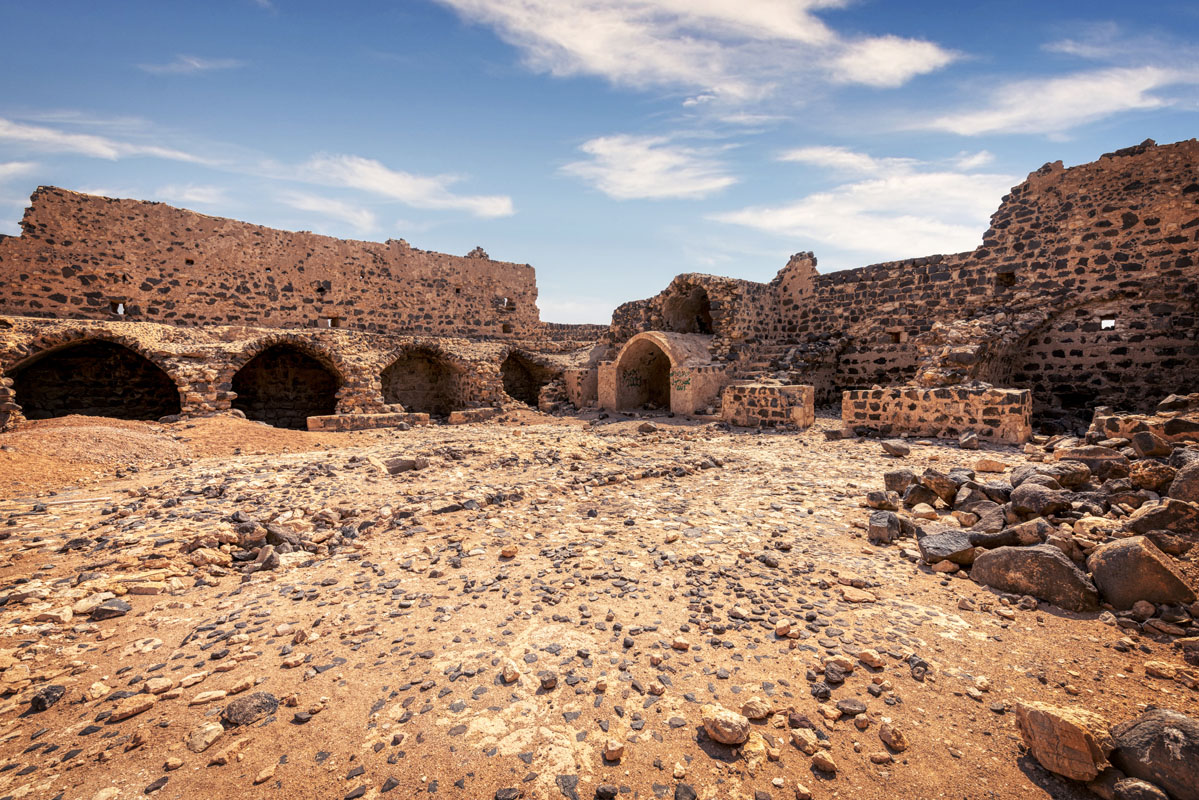
The site of Khan ‘Unaiza has a rich and multifaceted history, blending Roman, Ottoman, and modern elements across centuries of use and transformation. Evidence suggests the area may have housed a Roman caravanserai as early as the 2nd century, likely linked to the Via Militaris and the nearby fort at Da‘ajaniyya. After a long historical gap, the site re-emerges in historical records in the 16th century.
By 1563, Khan ‘Unaiza appeared in Ottoman texts, though it remains uncertain whether the listing references repurposed Roman structures or the Ottoman fort constructed later. Historical accounts point to Sulayman Pasha, who built the fort in 1576 or shortly thereafter, also contributing a similar construction at Hadiya.
Through time, notable visitors documented their impressions of ‘Unaiza. In 1709, Murtarda ibn ‘Alawan described it as a well-maintained, spacious structure owned by the Bani ‘Idha, who used it to assert their power. By the early 19th century, however, engineers under Muhammad ‘Ali Pasha found the fort in disrepair, deeming it unsuitable as a stop for pilgrims due to its condition and proximity to Ma‘an.
Later travellers, like Gray Hill in 1896, explored the site while en route to Petra, with Hill marvelling at its setting near Jabal ‘Unaiza. The following year, German scholars Brünnow and von Domaszewski noted a walled cistern still holding water, perhaps linked to the railway station established nearby in the early 1900s. This station became part of a 36-kilometre branch line to Shobek in 1916, fulfilling a vital role in the Hijaz railway by facilitating the transport of fuel wood.
Archaeological interest officially recognised the site in 1972, with the Jordanian Antiquities Department documenting the fort as an Antiquities Site. A more thorough examination came in the 1990s via the Dana Archaeological Survey, which confirmed pre-Ottoman remnants and identified the location as a major classical site along an ancient route to the Ma‘an oasis. Khan ‘Unaiza stands as a testament to evolving use and significance over millennia, showcasing layers of history etched into its stones.
